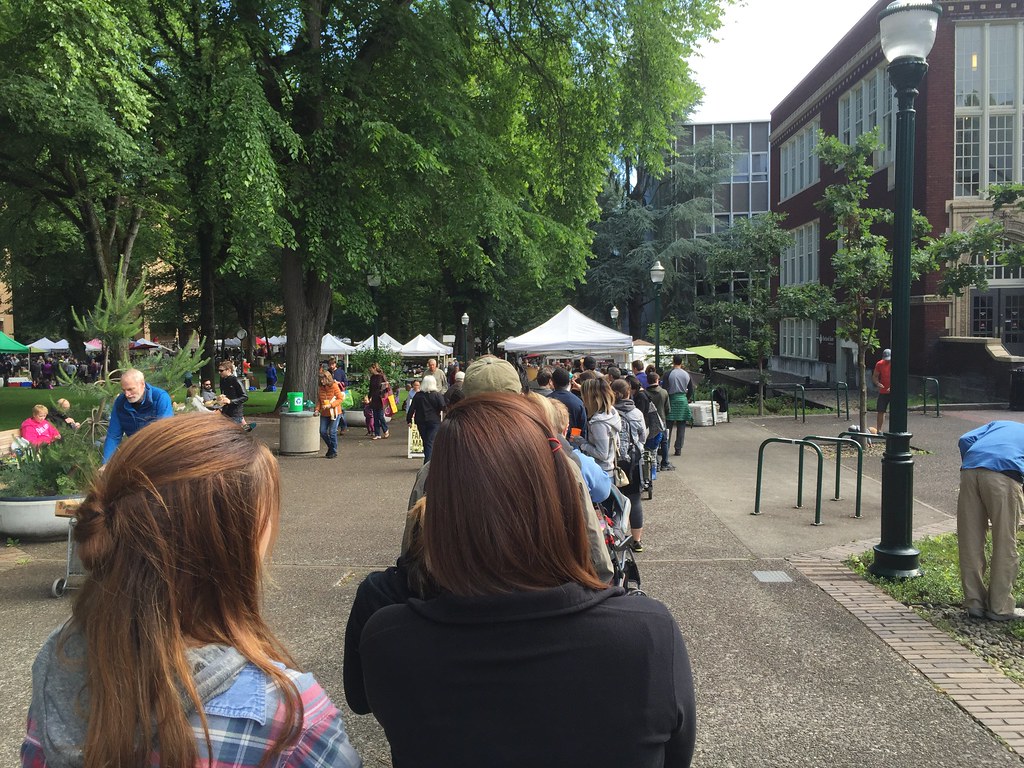
When I woke up this morning--slept late by an hour and a half, yea--I decided to not eat breakfast here. I wanted to go by bus to the Portland Farmers Market at PSU and then to the Stadium Fred Meyer on West Burnside. I knew that I could walk off the calories in a Pine State Biscuits biscuit, fried egg, and some strawberry jam. So, I got in the long line, watched people, passed the time successfully.
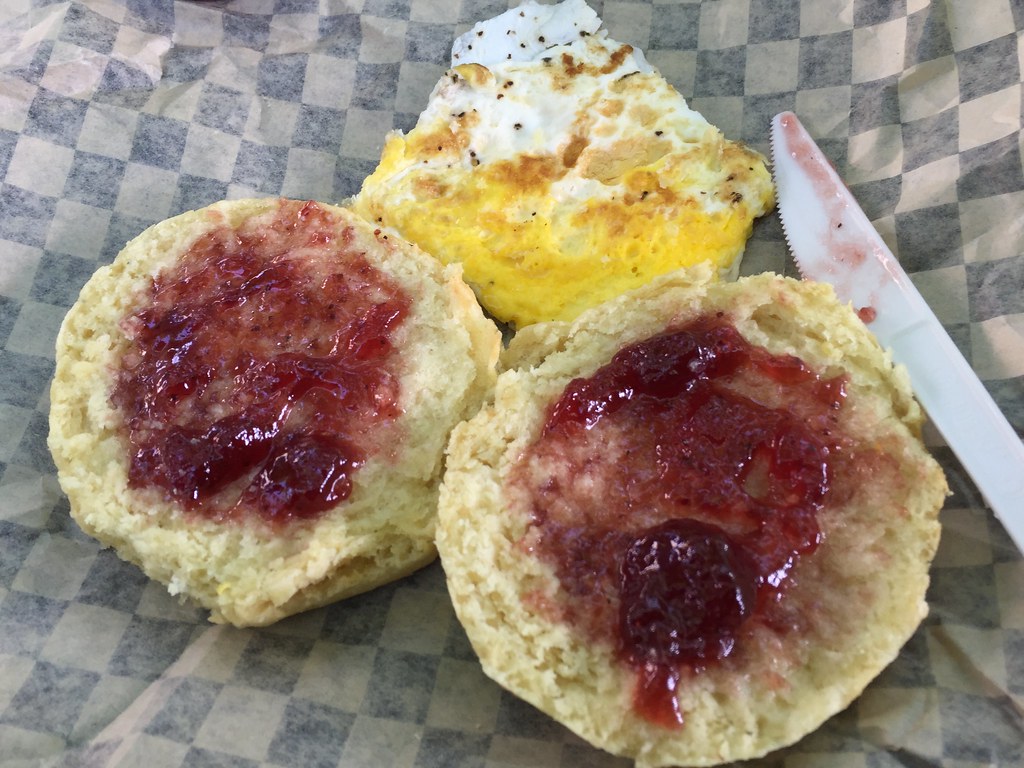
Delicious, every single bite!
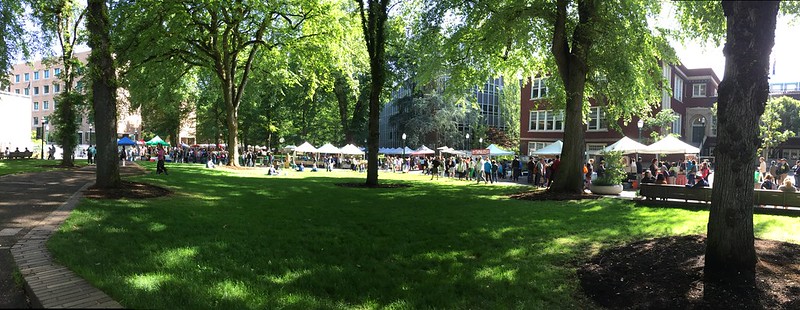
My view from the bench where I sat to eat. I'm at the southern end of the farmers market which takes up two full blocks in what's known as the South Park Blocks--they're on the campus of Portland State University, too. After the last photo in the post, I've put info I found online at the Portland city government Web site about the South Park Blocks.
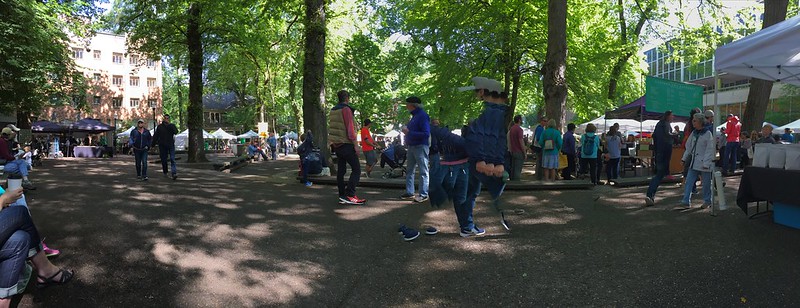
I walked the block and sat down to rest. As I shot this panorama image, a couple of guys walked from left to right in front of me, at practically the same speed that I moved my iPhone. Those are their body parts splayed about in the photo. I had no idea this would happen, but I find it sort of cool.
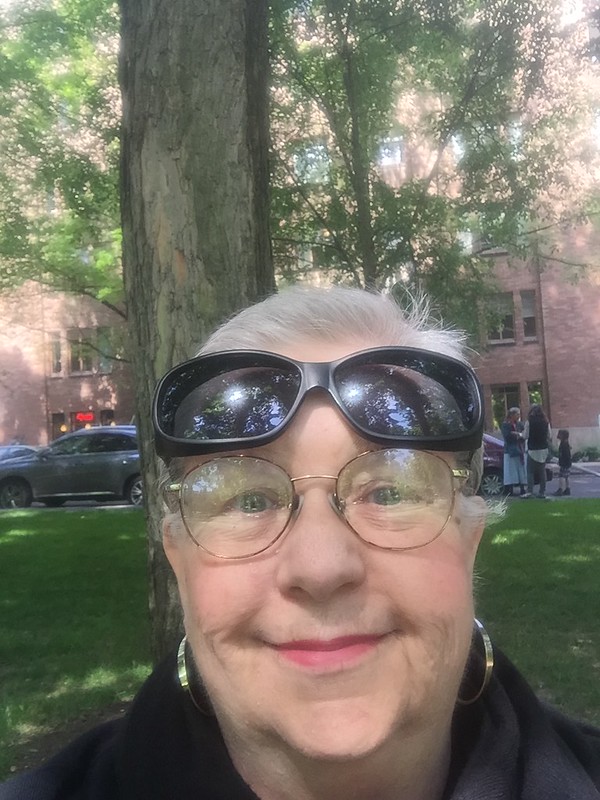
I decided to take this photo because I felt so happy sitting there in the shade, amazed by the blessings in my life.
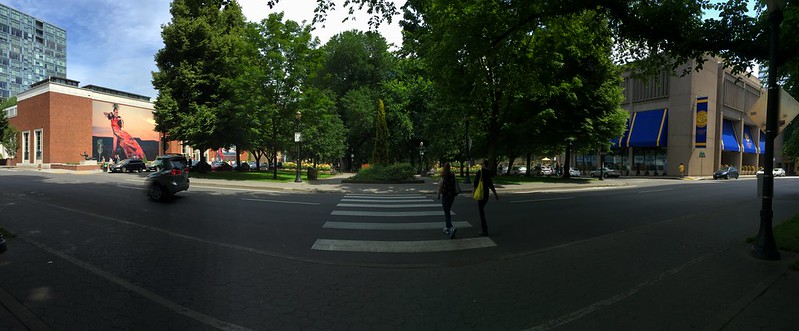
As I continued to walk north towards West Burnside, I thought this would make a great panorama photograph--the Portland Art Museum on the left, across the South Park Blocks, the Oregon Historical Society on the right.
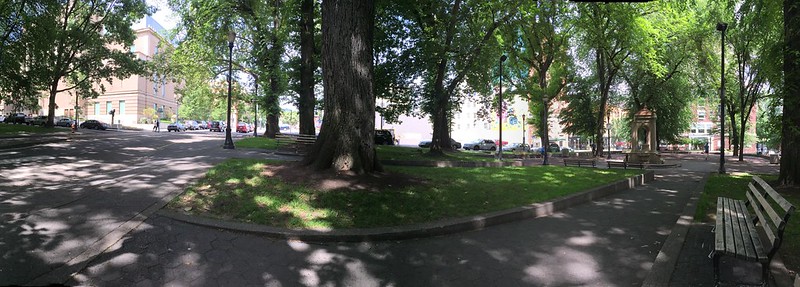
Once more I found a bench for a short rest. I'm at the southern edge of this park block which is known as Shemanski Park. I'm looking mostly west, a bit north. On Wednesdays, the Portland Farmers Market opens with an abbreviated number of vendors right here in the lovely spot. When I used to work 40 hours per week and had an hour for lunch, I'd ride a bus west across the Willamette, get off two blocks away and walk up the hill to shop for goodies. Now, I'm working 32 hours per week and have half an hour for lunch, so I don't do that which is one of the reasons I came to the PSU market last Saturday and shopped extensively.
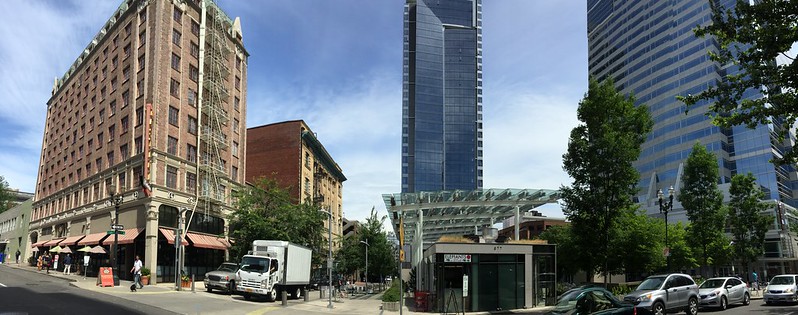
In between Shemanski Park and this view, there's a block full of downtown buildings. I can't remember what I heard for certain when on a tour of downtown, but it seems like there was something to do with the family who owned the block selling it. Anyway, this photo shows the southern edge of Director Park--from the little black building through those trees--which is the newest of the South Park Blocks. I don't know anything about buildings on the left side of the photo, drat it. (I don't have the energy after my busy hours to dig around on the World Wide Web.) The tall one in the center is interesting because for years after the economy went bust, it sat there, a huge, block-sized hole in the ground, not much visible other than rebars waiting for concrete and certainly nothing that caused one to be able to visualize the now finished 30-story tower. The high rise on the right is known as the Fox Tower.
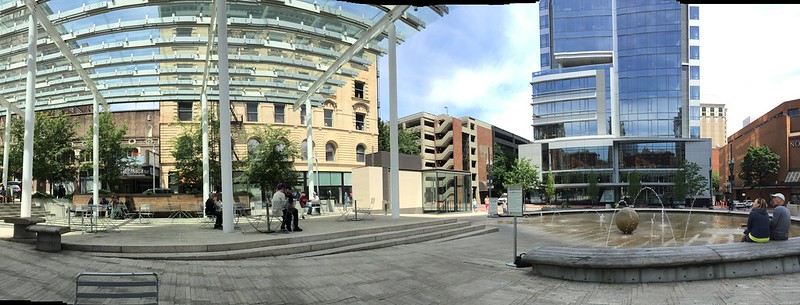
Here's a view of most of Director Park, including Teachers Fountain. On warm days, children run through the streams of water, squealing and having lots of fun. The park covers a 700-space underground parking garage, which connects underground to the Fox Tower and possibly that 30-story tower, too--I read online that was the original intent but didn't dig around to find out if it actually happened once the tower was completed.
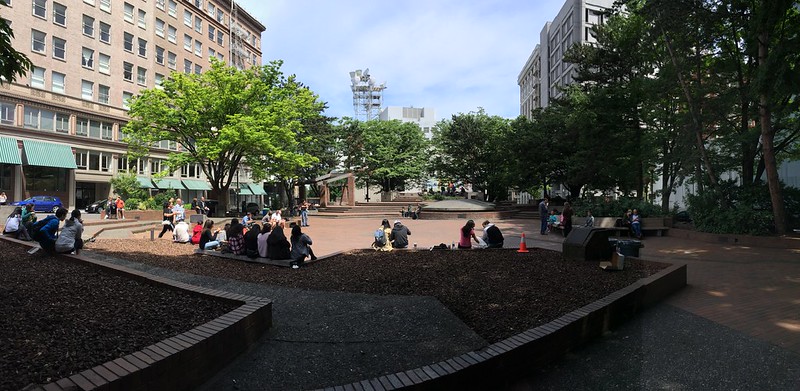
And here's O'Bryant Square, the final park that I got to photograph. I'm glad that I got a chance to photograph it and still made it to the bus stop for the 20 in time to just be able to get on board to ride the rest of the way to Stadium Fred Meyer. It irks me that I missed a chance to get a photo of the North Park Blocks which begin where I caught the 20, but they're not going anywhere, and I really needed to get on to Freddie's to buy some water to drink and to shop. After I took this, I walked as fast as I could get myself to go until I got to West Burnside, then I waited to cross safely and almost made it to the bus stop. The driver saw me and pulled to a stop for me a few feet west of the stop. Thanks, TriMet!
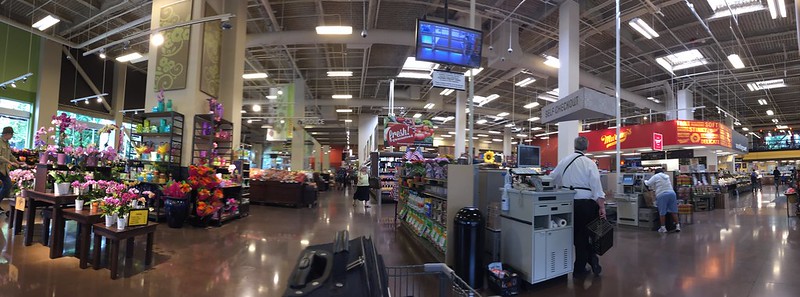
Once inside Freddie's, I spied an empty chair and sat down to get my wits about me. That's when I was a dumb ass because I took my phone out of my purse and set it in the grocery cart child seat on my black scarf so that I could easily check my list. I put my purse there and my camera bag, too. I should've put the phone in my pants' pocket! Dumb ass because the iPhone doesn't record movement (steps) when the thing is riding in a grocery cart! I figure during the hour that I wandered around shopping that I shorted myself maybe 1400 steps and burning maybe 200 calories. Yep. Dumb ass. At least I had enough sense to put the rolling black bag into the cart--see it at the center bottom of the photo. I would've never been able to roll it and the cart. Nope.
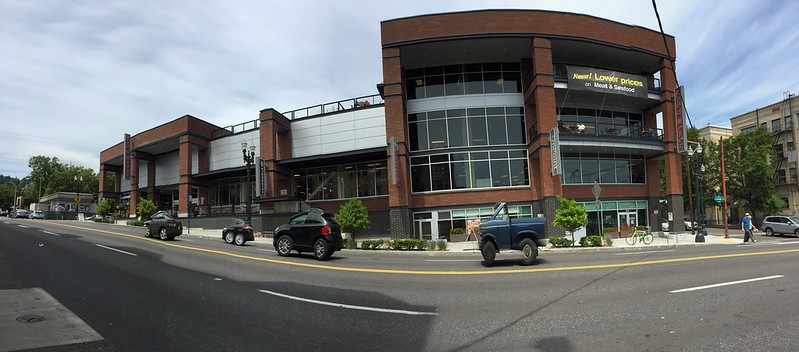
This photo has hilarious vehicles in it, squashed and/or down to nothing but wheels, thanks to taking a panorama photo with my iPhone. I sat in the bus shelter waiting for the 20 after packing my purchases carefully in my rolling black bag, my backpack, and one reusable shopping bag. I had three miles to go by bus to get home and knew that I'd be very happy that I had finished one 16 ounce bottle of water in the store and had bought one for the road. In order to be able to walk on level sidewalks, no sloping uphill with my very heavy rolling black bag for me, I got off two blocks past my street. I made it home just fine, finished that second bottle of water right after I got inside my apartment, put away the refrigerated items, made myself a proper sandwich with Franz Organic Twenty-Four Thin Sliced Bread, three ounces of baked chicken, and four Unbound Pickling bread and butter pickle slices, plus a little bit of Best Foods Real Mayo. Yummy. I drank two more glasses of water. I enjoyed three Tillamook strawberries that I had bought at the farmers market. Then, I went outside and walked for about 10 minutes and came back to work on this blog post. I drank two more glasses of water and ate half a cup of Breyer's Lactose Free vanilla ice cream with two more strawberries sliced into the bowl. Now my goal is to be able to stay awake for the Thunder vs Warriors at 6 p.m. I want the Thunder to finish it tonight!
In case you're interested, here's a good bit of info about Portland's spectacular South Park Blocks, found on the Internet:
General Info Acreage: 8.76 Acquired in 1869
Amenities Includes fountain, historical site, paths – paved, playground, Plaza, and statue or public art. Fountain Historical Site Paths – Paved Playground Statue Or Public Art
Special Information Park hours: 5:00am-9:00pm
Program Information
This park is maintained with the volunteer assistance of the Friends of South Parks Blocks. To find out how you can help at your neighborhood park, call 503-823-5121.
Historical Information
In 1852 Daniel H. Lownsdale designated eleven narrow blocks of his plat at the western edge of town for public park space. Between 1852-75 the park was an unimproved roadway on the outskirts of the city center; the southern portion up to Jefferson was part of the Great Plank Road. During the 1870s the area became a fashionable residential neighborhood with large Italianate mansions, schools, and churches. In 1877 the first landscaping of these blocks occurred when the City Council authorized florist and landscape designer Louis G. Pfunder to plant 104 Lombardy poplars and elms between Salmon and Hall. The Ladd School opened on the present Portland Art Museum site in 1879. In 1885 the city's first parkkeeper was appointed and a more formal park began to develop. Over the years, much has been added to the park, but there seems to be consensus that the blocks should remain "a cathedral of trees with a simple floor of grass."
By the 1880s many lots were subdivided for smaller residences; by the turn of the century, apartment buildings were developed. Lincoln High School was located at Park and Market. This later became the first Portland State University building. The campus from Market to Jackson was established in the 1950s. In 1973 the campus was redesigned and streets closed off.
Today there are twelve South Park Blocks stretching through the heart of downtown Portland. Each park block features artwork. On the block between Hall and Harrison is the most recent addition. Installed in 2004, this work made of white Indiana limestone by Oregon sculptor Donald Wilson is entitled Holon. The word comes from the Greek holos which means whole, entire, complete in all its parts - something that has integrity and identity at the same time as it is a part of a larger system. A block north at Montgomery is the 1973 bronze statue and fountain Farewell to Orpheus by Frederic Littman (1907-79).
In the center of the block between Market and Clay is a granite mosaic sculpture by Oregon artist Paul Sutinen. In the Shadow of the Elm, installed in 1984, depicts the shadow of a tree that may have once existed within the grid of trees in the block. In the center of the block between Columbia and Jefferson is a very different sculpture, also installed in 1984. Comprised of three large granite pillars, Peace Chant is the first known peace memorial in Oregon. Sculptor Steve Gillman wished to express his own advocacy for peace as well as that of the nearby churches. In May 1985 the City Council named this block Peace Plaza.
Between Jefferson and Madison stands an 18-foot-tall bronze equestrian statue of Theodore Roosevelt by New York sculptor Alexander Phimister Proctor (1860-1950), who was known for his western art. Mounted on a 14-foot tall base of California granite, the statue entitled Theodore Roosevelt - Rough Rider portrays the colonel in the actual uniform and accoutrements he wore in his famous ascent of San Juan Hill during the Spanish-American War. It was presented to the city by Dr. Henry Waldo Coe. When Dr. Coe was just beginning his medical practice in 1884 in North Dakota, he met the young Roosevelt, who was there trying to regain his health. Their friendship lasted until Roosevelt's death in 1919. Aside from his personal friendship, Coe (who moved to Portland in 1891) admired Roosevelt's politics. It was mostly for this reason that he decided to express his admiration in the form of a public statue. Calvin Coolidge broke ground for the statue in August 1922 and it was unveiled on November 11 of that year. The block was named Roosevelt Square.
The block between Madison and Main was named Lincoln Square because of another donation by Dr. Henry Waldo Coe - a 10-foot bronze statue of Abraham Lincoln on a granite base. Sculpted by George Fite Waters and cast at the famous foundry of Claude Valsuani in France on Lincoln’s birthday in 1927, the statue was unveiled on October 5, 1928.
Located between Main and Salmon is the Shemanski Fountain, given to the city by Joseph Shemanski in 1926 to "express in small measure gratitude for what the city has done for me." Shemanski (1869-1951) was a Polish immigrant who started out as a traveling clock salesman before he founded the Eastern Outfitting Co. and became an extremely successful businessman. The triangular structure of cast Oregon sandstone was designed by Carl L. Linde, a local architect whose work included many fine homes, hotels, and apartments. The fountain includes three small, low drinking basins for dogs.
The original design included a large central planter, but after the fountain was erected, Shemanski felt that a sculpture would better complete the graceful cupola. He commissioned Oliver Laurence Barrett, an art professor at the University of Oregon, to create a bronze statue of Rebecca at the Well. It is not clear why Rebecca was chosen, but as the wife of Isaac in the Old Testament known for her hospitality to strangers and kindness to animals, she was a fitting choice.
At the northern end of the block at Salmon sits the Simon Benson Memorial which was constructed in 1959. It was planned by architect Albert E. Doyle while designing the Benson Hotel. A round bronze plaque with a bas relief of Simon Benson, timber baron and philanthropist, is mounted on the curved brick wall with stone benches. He looks out at a drinking fountain which represents one of the 24 bowl fountains that Benson gave to the city in 1912.
The newest park on the Blocks is Simon & Helen Director Park located between Taylor & Morrison. The site was a surface parking lot donated to the city by real estate developer Tom Moyer who also made a substantial contribution toward the design and construction of the park. Another generous contribution was made by philanthropist Jordan Schnitzer who named the park in honor of not only his maternal grandparents, but of all immigrants who helped to build Portland. The design team was led by internationally-renowned landscape architect Laurie Olin whose projects include Bryant Park and Battery Park in New York City and Canary Wharf in London.

3 comments:
I like your city scenes and commentary, felt like I was walking along. Those squashed vehicles are funny. Enjoy your holiday weekend!
Your shot of the splayed fellows definitely is cool. Our main market is on Sundays, and I always pop in.
Wow looks like you had a busy day. I am glad to see you getting back into some of your weekend fun. Oh and anything moving in the panorama shots will do that. The software does it when the shot are stitched together. Kendra got a sick shot of Lamont on Sunday where this effect made it look like his arm was huge. I will try to get her to send it to me so I can share it with you. I throughly enjoyed the tour!
Post a Comment